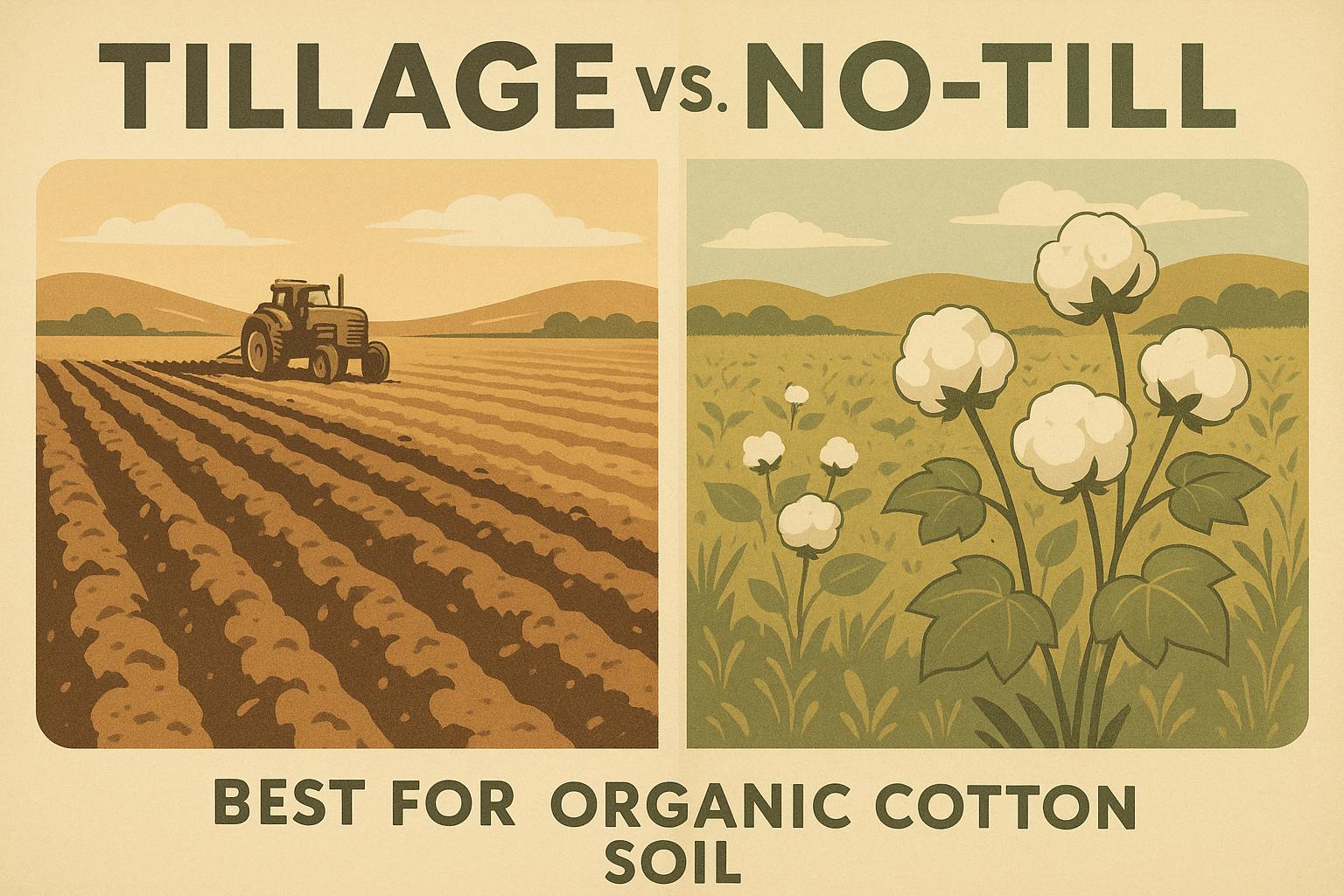- Round Cotton Modules: These are cylindrical cotton bales wrapped in UV-resistant plastic during harvesting. They weigh between 4,400–5,500 lbs and are 94" in diameter and 96" wide.
- Why Handling Matters: Improper handling can lead to contamination, moisture issues, or damage, reducing cotton quality and profitability.
- Field Placement: Place modules on level, debris-free ground, spaced 4–8 inches apart for airflow. Avoid slopes or areas prone to water pooling.
- Wrap Care: Prevent tears in the plastic wrap by lifting modules, avoiding sliding, and repairing damage immediately.
- Transport Tips: Use proper equipment (forks, telehandlers) and secure modules end-to-end during transit to avoid shifting.
- Gin Yard Management: Inspect for contamination, store modules on stable surfaces, and follow strict unwrapping and fire safety protocols.
- Plastic Contamination: A growing issue, with 17% of plastic remaining in processed lint. Vigilance during every step is crucial.
Quick Comparison: Round vs. Rectangular Modules
| Feature | Round Modules | Rectangular Modules |
|---|---|---|
| Formation | Automatic during harvest | Requires separate module builder |
| Protection | UV-resistant plastic wrap | Manual tarping |
| Size | 94" diameter x 96" width | 32' length |
| Handling | Needs specialized equipment | Uses traditional equipment |
| Airflow | Better ventilation | Limited airflow |
Proper handling ensures cotton quality, reduces contamination, and protects profitability. Follow these steps to maintain high standards from the field to the gin.
Handling round cotton modules
Field Collection Steps
Efficient field collection is crucial for maintaining cotton quality and reducing contamination. Contamination-related losses currently cost the U.S. cotton industry between $600 million and $750 million each year.
Module Placement in Fields
When placing modules in the field, choose areas that are level, well-drained, and free of debris. On sloped terrain, position modules across the slope rather than along it to prevent rolling.
| Placement Factor | Practice | Benefit |
|---|---|---|
| Module Spacing | Leave 4–8 inches between modules | Promotes air circulation and prevents moisture buildup |
| Height from Ground | Keep modules at least 12 inches off the ground | Protects wrap from stalk damage |
| Alignment | Centerlines within ±5 inches | Reduces risk of damage during truck loading |
| Surface Type | Use bare soil or turn-rows | Provides a stable base |
Arrange modules in groups of four with proper spacing to improve airflow and simplify loading onto trucks.
"This helps two ways. If you do get rain, the round modules withstand weather very well. But if they're placed too close together and get rain, you'll start seeing boll or mildew growth and degradation of the cotton in that area." - Tommy Valco, cotton technology transfer coordinator for USDA-ARS
Once modules are properly placed, the next priority is protecting the wrap during handling.
Module Wrap Care
To preserve the integrity of the module wrap, follow these practices:
- Lift modules at least 12 inches off the ground during handling.
- Avoid sliding modules across the field surface.
- Place modules on clean, flat areas away from stalks or sharp debris.
- Repair any wrap damage before transporting.
"It's going to take vigilance on the part of everybody. It's not a farmer problem. It's not a ginner problem. It's an everyone problem".
Operate equipment at reduced speeds to prevent tearing or puncturing the wrap. Staging areas should be elevated to allow proper rain runoff while still providing easy access for transport vehicles.
Studies indicate that yellow and pink plastic wrap materials are the most common contaminants found in processed cotton. Proper handling of these materials is essential to maintaining the U.S. cotton industry's reputation in the global market.
Safe Transport Methods
Transporting cotton from the field to the gin requires careful planning and execution to preserve its quality. Once field collection is complete, the next step is ensuring the cotton modules are handled and transported with care.
Loading Steps
Proper equipment and positioning are crucial during module staging. Module trucks typically carry up to four modules, while semi-trailers can handle six. Given that each module weighs over 6,000 pounds, using tractor-mounted equipment with sufficient power is essential.
| Equipment Type | Usage | Key Consideration |
|---|---|---|
| Three-point hitch forks | Primary staging | Hydraulic spacing control |
| Mast-mounted implements | Module positioning | Minimum 12-inch lift height |
| Front-end loader forks | Alternative method | Requires careful alignment |
Modules should always be arranged end-to-end rather than side-by-side, following the spacing guidelines outlined in the Field Collection Steps. This arrangement ensures stability during loading and transit.
Once the modules are securely loaded, the focus shifts to keeping them stable during transport.
Load Security
Transporting cotton modules safely involves specific equipment and techniques:
-
Chain-bed Requirements
Module trucks must use chains with rounded cleats to avoid damaging the cotton wrap. Regularly inspect truck walls to ensure there are no sharp edges or burrs that could cause tears. -
Loading Protocol
Telehandlers or wheel-loaders are ideal for placing modules on flatbed trailers. Their precision helps ensure modules are positioned securely. -
Restraint Systems
Follow the guidelines from the Cotton Australia Module Restraint Guide to secure modules properly. Arranging modules "sausage-style" (end-to-end) provides the best stability during transport.
Transport Rules
Adhering to transport rules is essential to protect the quality of the cotton. Key considerations include:
- Adjusting transport speeds based on road conditions
- Securing modules to prevent shifting during transit
- Staging on flat, stable surfaces
- Avoiding areas prone to water accumulation
- Ensuring cotton moisture levels are 12% or lower before transport
Modern round modules often come equipped with RFID tags. These tags track critical data points, enhancing traceability and quality control throughout the transport process.
"The tighter the module is compacted, the better it sheds rainfall on the sides and the less seed cotton is lost during storage, loading and hauling." - Cotton Incorporated
sbb-itb-0e617ca
Gin Yard Management
Managing cotton modules at the gin yard is crucial to maintaining cotton quality and avoiding contamination. The National Cotton Council underscores the importance of a "zero tolerance" policy when it comes to contamination in both seed cotton and lint.
Unloading Process
Proper unloading of cotton modules is essential to protect their quality during the ginning process. Here's how to handle this step effectively:
| Stage | Action | Purpose |
|---|---|---|
| Initial Inspection | Check trucks for contaminants | Prevent contamination transfer |
| Module Placement | Place on a stable, level surface | Preserve structural integrity |
| Unwrapping | Use precise cutting techniques | Prevent plastic from mixing with cotton |
To ensure quality, gin operators should use equipment that allows for accurate module rotation, making it easier to cut at the correct locations. After unloading, cleanliness should be a top priority, with thorough inspections and regular maintenance.
Keeping Cotton Clean
Plastic contamination continues to be a major issue for the U.S. cotton industry, leading to significant financial losses and harming its reputation in the global market. To combat this, strict inspections and careful handling are essential. Key steps include:
- Inspecting seed cotton regularly to ensure wrap integrity.
- Monitoring for any signs of moisture damage.
- Conducting daily equipment inspections.
- Keeping processing areas clean and free of debris.
- Storing tools and fasteners in designated areas.
- Regularly checking safety devices.
- Ensuring transportation equipment is clean before use.
Fire Prevention
Maintaining a safe gin yard isn’t just about cleanliness - it’s also about fire safety. Preventing fires and being prepared for emergencies are critical. Key measures include:
- Keeping 20-foot-wide emergency lanes clear around all structures.
- Installing ABC dry-chemical fire extinguishers for quick response.
- Removing brush, weeds, and other combustible materials from the area.
"Education is the key to prevention." - Ron Craft, NCC Chairman
Fire incidents at cotton facilities can have devastating financial impacts. From 2013 to 2017, such fires caused an estimated $28 million in annual property damage. To minimize these risks, gin yards should focus on comprehensive employee training programs that address both contamination prevention and fire safety protocols.
Using cottongins.org
Combining effective on-ground practices with online tools can make delivery operations smoother and more efficient. One such tool, cottongins.org, plays a key role in optimizing module handling and improving delivery logistics.
Gin Location Search
Finding nearby gins is crucial for reducing transport time and ensuring the quality of cotton modules. With the comprehensive gin directory on cottongins.org, users can:
- Search by location, access detailed addresses, and plan routes to save on transport costs.
This feature becomes especially important during the busy harvest season when timely and efficient transport helps protect cotton quality and maintain wrap integrity.
Adding New Gins
Adding your gin to the directory increases its visibility among producers. The process is straightforward:
| Step | Action | Benefit |
|---|---|---|
| Submit Entry | Use the 'Submit A Gin' feature | Ensures your facility is listed |
| Provide Details | Include operating hours and contacts | Helps producers plan deliveries |
| Verify Information | Double-check location data | Reduces delivery errors |
Being listed in the directory can expose your gin to over 10,000 daily users actively searching for locations.
Gin Sponsorships
cottongins.org also offers sponsorship opportunities designed to strengthen gin operations and foster industry connections. For instance, sponsors like CropRX, L.P. Brown, R&C Supply, Robinson's Sheet Metal, Samuel Packaging, and Tama USA Inc supported the California Cotton Ginners and Growers Association's 2025 Ginners School & Managerial Seminar.
Here’s a breakdown of sponsorship options:
| Type | Cost | Benefits |
|---|---|---|
| Sponsored Post | $200 per post | Top placement for 24 hours and social sharing |
| Official Sponsor | $200 per month | Footer placement and one free post annually |
| Featured Sponsor | $400 per month | Premium placement and two free posts annually |
The Western Agricultural Processors Association (WAPA), which shares resources with the California Cotton Ginners and Growers Associations, highlights the collaborative spirit of the industry. These online tools not only simplify logistics but also strengthen connections across the cotton industry, complementing on-field operations and gin yard management.
Summary
This section highlights effective field and transport strategies to maintain cotton quality and reduce losses. Research indicates that well-maintained modules can save up to $600 each, with modules ginned before rain achieving a 34.6% turnout at 49.1 bales/hour, compared to 26.2% turnout at 18.6 bales/hour.
Field and transport data emphasize the importance of systematic practices to protect module quality. To minimize contamination and preserve value, consider these key actions:
| Practice | Impact | Key Action |
|---|---|---|
| Moisture Control | Prevents yellowing above 14% moisture | Store modules on well-drained ground |
| Module Spacing | Improves air circulation | Place modules 4–8 inches apart |
| Wrap Protection | Reduces contamination | Repair tears immediately with proper tape |
To enhance results, use cottongins.org to locate nearby gins and plan efficient delivery routes. This proactive approach helps safeguard cotton quality, as delayed ginning can lead to microbial growth and fiber degradation.
Additionally, studies reveal that 56% of plastic entering a gin is removed by stick machines, but 17% remains in the lint. This highlights the importance of proper wrap care and careful handling from the field to the gin.
FAQs
What causes plastic contamination in cotton modules, and how can it be prevented during handling and transport?
Plastic contamination in cotton modules typically stems from damaged wraps, leftover debris in the field, or mishandling during transport and ginning. For instance, dropping modules onto cut stalks can puncture the plastic, while improper alignment or unsynchronized equipment used by loaders or trucks often leads to wrap damage.
To reduce the risk of contamination, it’s important to maintain clean fields, use durable module wraps, and handle modules with care to prevent tears or punctures. Additionally, training workers on proper handling techniques plays a key role in keeping plastic debris out of the cotton during both harvesting and processing.
How does the placement and spacing of round cotton modules impact their quality and risk of contamination?
Proper placement and spacing of round cotton modules play a key role in preserving their quality and minimizing contamination risks. Leaving 6 to 8 inches of space between modules promotes good air circulation, which helps keep moisture levels in check and reduces the likelihood of mold or spoilage. Placing the modules on well-drained surfaces and steering clear of low-lying areas further protects them from waterlogging and potential contamination.
Equally important is avoiding contact with sharp objects, like cut stalks, when handling the modules. Such objects can tear the plastic wrap, increasing the chances of plastic contamination in the cotton. Thoughtful placement and handling go a long way in maintaining cotton quality and ensuring a smoother process when it’s time for ginning.
What are the best practices and recommended equipment for safely transporting round cotton modules from the field to the gin?
To safely transport round cotton modules while reducing the risk of damage and contamination, it’s essential to stick to a few key practices.
Start by using trailers specifically designed for cotton module transport. Metal van-type trailers or trailers equipped with tarps work best, as they shield the modules from dust, moisture, and other elements during transit. Securing the modules properly is just as important. Use multiple straps to keep them stable - place one strap over each top module and two straps on the rear module, ensuring they are firmly attached to the trailer frame. This setup helps prevent shifting and minimizes potential damage.
These precautions go a long way in preserving the quality of the cotton, ensuring it arrives at the gin in excellent condition.


